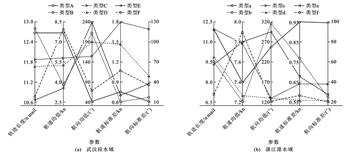| 多特征融合的船舶轨迹相异度模型分析与优选 |
| |
| 引用本文: | 刘磊, 张永, 张明阳, 王永明, 陈静. 多特征融合的船舶轨迹相异度模型分析与优选[J]. 交通运输工程学报, 2021, 21(5): 199-213. doi: 10.19818/j.cnki.1671-1637.2021.05.017 |
| |
| 作者姓名: | 刘磊 张永 张明阳 王永明 陈静 |
| |
| 作者单位: | 1.东南大学 交通学院,江苏 南京 211100;;2.阿尔托大学 机械工程学院,艾斯堡 02210;;3.大连海事大学 航海学院,辽宁 大连 116026 |
| |
| 基金项目: | 国家自然科学基金项目72071041江苏省交通运输科技项目2018Y02 |
| |
| 摘 要: | 
基于船舶自动识别系统轨迹,构建了船舶轨迹静态相异度模型、动态相异度模型以及组合相异度模型,包括轨迹起点和终点相异度模型、轨迹长度相异度模型、轨迹空间分布相异度模型、轨迹航速均值相异度模型、轨迹航向均值相异度模型、轨迹航速标准差相异度模型和轨迹航向标准差相异度模型;采用KNN分类算法进行轨迹分类,分析了单个相异度模型的有效性和时效性,对比了单个相异度模型和组合相异度模型下轨迹分类效果,研究了组合相异度模型中相异度模型的类别和权重对轨迹分类的影响;分别以内河航道和港口水域船舶轨迹进行试验。试验结果显示:在采用单个相异度的情况下,就分类效果而言,轨迹起点和终点相异度模型和轨迹航向均值相异度模型在内河航道和港口水域船舶轨迹分类效果均优于其他模型,而基于轨迹航速均值相异度模型和轨迹航速标准差相异度模型的轨迹分类效果最低,就分类效率而言,基于航速、航向均值和标准差的相异度模型耗时明显低于其他3个相异度模型;采用组合相异度进行轨迹分类,内河航道和港口水域船舶轨迹分类结果的基于精确率和召回率的宏平均值和微平均值均能接近99%;将组合相异度中相异度类别数由4个增加到7个,轨迹分类评估结果进一步得到提高。
因此,单个相异度模型中以轨迹起点和终点相异度模型、轨迹航向均值相异度模型以及轨迹空间分布相异度模型分类效果最优且稳定,而轨迹空间分布相异度模型和轨迹长度相异度模型耗时明显高于其他方式,各相异度模型在不同场景中的适应性基本相似,通过增加组合相异度中相异度类别能够提高轨迹识别效果。

|
| 关 键 词: | 交通信息工程 船舶自动识别系统 船舶轨迹相异度 KNN算法 轨迹分类 轨迹空间距离 |
| 收稿时间: | 2021-04-15 |
| 本文献已被 万方数据 等数据库收录! |
| 点击此处可从《交通运输工程学报》浏览原始摘要信息 |
|
点击此处可从《交通运输工程学报》下载免费的PDF全文 |
|



